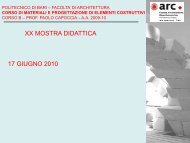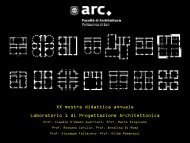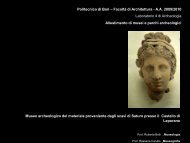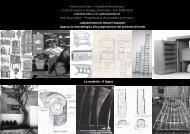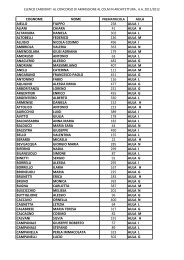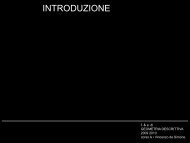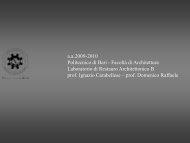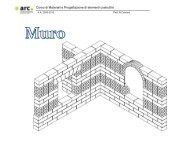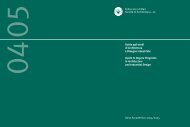Scarica il file pdf - Politecnico di Bari
Scarica il file pdf - Politecnico di Bari
Scarica il file pdf - Politecnico di Bari
You also want an ePaper? Increase the reach of your titles
YUMPU automatically turns print PDFs into web optimized ePapers that Google loves.
sociale dell’abitare (Loos, Tessenow, BrunoTaut, Gropius, la “moderna casa italiana”).3.5. Dissoluzione degli or<strong>di</strong>ni e ritorno allanatura: <strong>il</strong> nuovo paesaggio domestico el’artigianato industriale (Arts and crafts,Wiener Werkstaette, ecc.)3.6. La ripresa degli or<strong>di</strong>ni e la formacostruita: Schmitthenner e la scuola <strong>di</strong>Stoccarda3.7. L’insegnamento della storiadell’architettura nelle scuole <strong>di</strong> architetturaeuropee e la nascita delle Facoltà <strong>di</strong>Architettura italiane (Gustavo Giovannoni ela Regia Scuola <strong>di</strong> Architettura <strong>di</strong> Roma).4. Il Movimento Moderno4.1. Principi e teorie del MovimentoModerno4.2. ‘St<strong>il</strong>e’ <strong>di</strong> Gropius, Le Corbusier, Mies: <strong>il</strong>loro contributo alla formazione della teoriae della pratica del Movimento Moderno4.3. Il novecento italiano (Piacentini,Muzio, ecc.)4.4. Il razionalismo italiano (Terragni, <strong>il</strong>Gruppo 7, ecc.)4.5. Il neorealismo4.6. L’ International Style e Louis I. KahnTopics1st session. Origins of contemporaryarchitecture: the ‘split’ between form andstructure.1.1. Analytic thinking Vs synthetic thinking(from projective geometry of GirardDesargues to orthogonal projections ofGaspard Monge;); Écoles PolytechniquesVs Beaux Arts; crisis of architecturalclassical composition and composition likears combinatoria.1.2. The Schools of Architecture andEngineering between 18th and 19thcenturies. Stereotomy like pivot <strong>di</strong>sciplineof educational activities. Theoretical attackto stereotomy, and its crisis.1.3. The heritage of Enlightenmentarchitecture in Europe: Rondelet andDurand.1.4. E. E. Viollet-le-Duc: innovation andtra<strong>di</strong>tion in architecture1.5. Gottfried Semper and ‘The Style’1.6. Neoclassicism: F. G<strong>il</strong>ly, K.F. Schinkel, L.von Klenze, the Hansen brothers.2nd session. Origins of contemporary city:the ‘split’ between techniques of bu<strong>il</strong><strong>di</strong>ngarchitecture and techniques of bu<strong>il</strong><strong>di</strong>ng thecity.2.2. Crisis of historic city of the 18th centuryand the city of 19th century.2.3. Crisis of the 19th century’s city, and the20th city.2.4. Architecture and cities in Italy beforeand after the national unity: Rome likestudy case.2.5. Architecture and cities inMe<strong>di</strong>terranean region: Algeri like studycase.3rd session. From 19th to 20th century:<strong>di</strong>ssolution of architectural orders andcome back to nature Vs “rappel a l’ordre”and classicism.3.1. Architects and ‘the line’: Gaudì, Horta,Wagner, Olbrich, Hoffmann.3.2. Architects and the ‘constructed form’:Perret and Asplund.3.3. Theory and practice of the ‘modern’dwelling: the new living civ<strong>il</strong>ization(Muthesius, van de Velde, Hoffmann).3.4. The living modern space: esthetics ofthe avant-garde and the problem of thesocial housing (Loos, Tessenow, BrunoTaut, Gropius, la “moderna casa italiana”).3.5. Dissolution of architectural orders andcome back to nature: the new domesticlandscape and the ‘industrial’ han<strong>di</strong>craft(Arts and crafts, Wiener Werkstaette, etc.).3.6. The orders’ revivals and theconstructed form: Schmitthenner and theStuttgart school.3.7. Teaching of architecture in theEuropean schools and the birth of theItalian ones: Gustavo Giovannoni and theRegia Scuola <strong>di</strong> Architettura <strong>di</strong> Roma.4th session. The Modern Movement.4.1. Principles and theories of ModernMovement.4.2. ‘Style’ of Gropius, Le Corbusier, Mies:their contribution to theory and practice ofthe Modern Movement4.3. The Italian Novecento: Piacentini,Muzio, etc.4.4. Italian Rationalism: Terragni, theGruppo 7, etc.4.5. Italian Neorealism4.6. The International style and Louis I.Kahn.Iscrizione al corsoLe iscrizioni al corso avvengonoobbligatoriamente sulla piattaforma e-learning entro i primi <strong>di</strong>eci giorni dall’iniziodei corsi. Per frequentare <strong>il</strong> corso esostenere l’esame lo studente deve essereregolarmente iscritto al terzo anno. Èammessa l’iscrizione con riserva (e quind<strong>il</strong>a possib<strong>il</strong>ità <strong>di</strong> sostenere l’esame negliappelli straor<strong>di</strong>nari invernali) per queglistudenti che sosterranno prima gli esamimancanti del secondo anno.Modalità d’esameL’esame si sostiene in forma scritta, econsiste: a) nella risposta a quesitiriguardanti <strong>il</strong> programma svolto; b) nel<strong>di</strong>segno a mano libera (piante, prospetti,sezioni) <strong>di</strong> e<strong>di</strong>fici <strong>il</strong>lustrati nel corso dellelezioni.44.2.10 Progetti <strong>di</strong>dattici del II ciclo del CdLm in Architettura99




